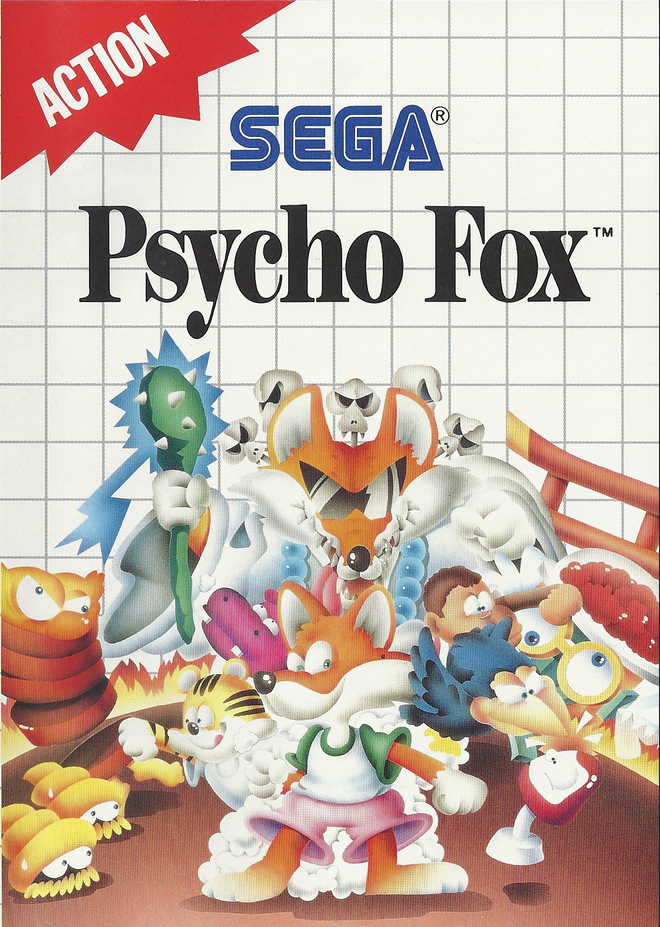
PLAYERS: 1
PUBLISHER: Sega
DEVELOPER: Vic Tokai
GENRE: Platformer
RELEASE DATE: 12/1989 (EU), 05/90 – (US)
Psycho Fox has the kind of brash ideas that could get a platformer in trouble. Take your bird friend, Bird Fly. When you find him all curled up in an egg, he’ll attach onto your shoulder and become your primary method of attack. But he doesn’t move straight. He flies where he wills, often in a curve. When he happens to hit an enemy, or they run into him, they die. But if you get hit once with Bird Fly, Bird Fly flies away, and Psycho Fox and his associates are left with awkward jumps and a punch for attacks. He’s cute, but his attack is only useful if your enemies are far away. Sometimes a punch is more effective than Bird Fly’s misguided swoops, but you can only punch when Bird Fly is apart from you. He gives and takes away.
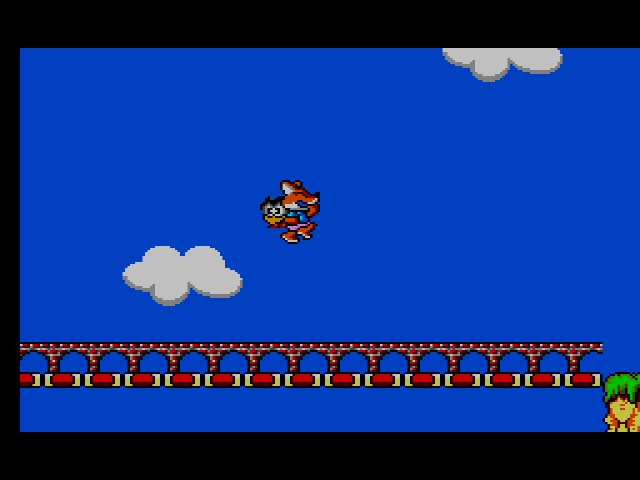
There are more ideas, but first, a little background. You play as the titular fox, though he’s far less psychotic than the name suggests. He’s a shapeshifter too (fancy that) who can shift between a Hippo, Monkey and Tiger. You can’t just switch between them whenever you want, though. Shape-shifting takes effort, and more importantly, items known as Psycho Sticks. Eat one and you’ll have the power to transform (but if you want to switch back to the fox, you’ll have to eat another one). Your cohorts all have different abilities – Hippo can punch through walls, Monkey can jump high, and Tiger can run and jump long distances – and while their abilities are useful here and there, you won’t really need their services unless you’re in a jam.
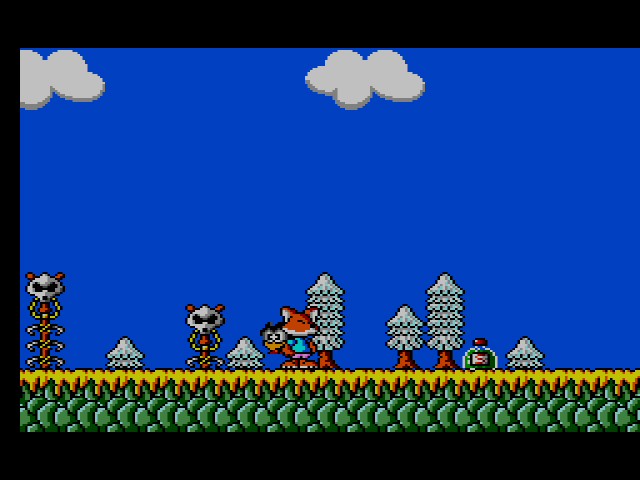
The inertia-based physics system is Psycho Fox‘s most shocking idea. In a day where every platformer character controlled more or less like Mario, Vic Tokai tried to distinguish themselves from the Regular Fox pack. So what does “inertia-based physics” mean exactly? Well, Psycho Fox controls like a male teenager who’s just gone through puberty: full of strength and energy at times, while listless at others. You don’t want Psycho Fox to run too fast through the levels, lest he fall into water or hit an enemy. But you want him to move quickly enough to jump over platforms and enemies. If you’re moving slowly and an enemy comes upon you, jumping and landing on said enemy becomes a monumental task, simply because Psycho Fox doesn’t have any forward momentum. And since Psycho Fox is a one-hit kill type of game (unless you have Bird Fly, then he can take an extra hit), you really want to learn how to control him well.
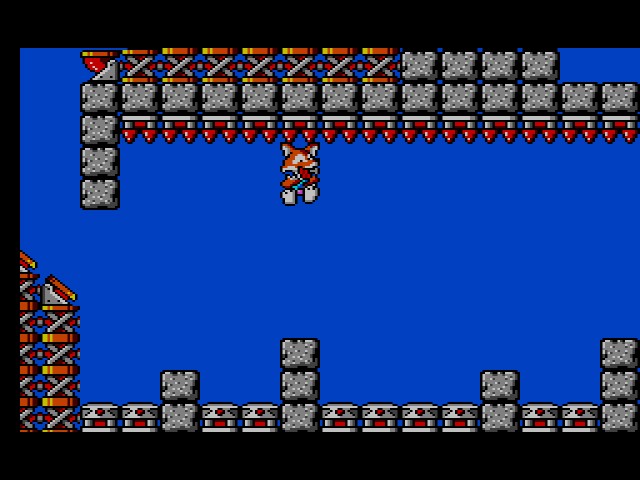
The levels – seven worlds, three levels each, twenty-one levels total – have multiple pathways, which encourage exploration and replay value. Often, the game provides three different paths, the ground, the middle, and the high road. There is no telling which of these paths will be the hardest in any given level, but if you pick a path that seems intent on killing you with obnoxiously placed enemies, claustrophobic corridors, or precarious jumps near water or beds of spikes, rest assured, you’ll probably be rewarded with eggs, which either contain special items or enemies. While the worlds all have different themes – Skull Land, Wind Zone, Ice Zone, etc. – the levels in the worlds take advantage of Psycho Fox’s strengths and weaknesses. You can bounce on water (provided you’re running)! You can swing on poles! When you bounce on enemies’ heads, you squish them into the ground until they disappear! And you have to do it all perfectly or the game punishes you.

Eggs – otherwise known as item containers – start off in abundance at the beginning, but as you progress to harder stages, they can only be found in clusters in hard-to-reach locations. The items themselves are ok, though to be honest, I hardly used them. The aforementioned Psycho Stick is a necessity at times, the Straw Effigy and the Magic Medicine less so. The latter gives you invincibility, which is great for as long as it lasts, while the former eliminates all enemies on screen. Since there are rarely many enemies on screen as it is, I usually just took to killing them via Bird Fly or a punch/jump. The best items are the 1-Up, represented by a silhouette of your character that runs away from you, and a money bag, which gives you a chance to play the bonus round.
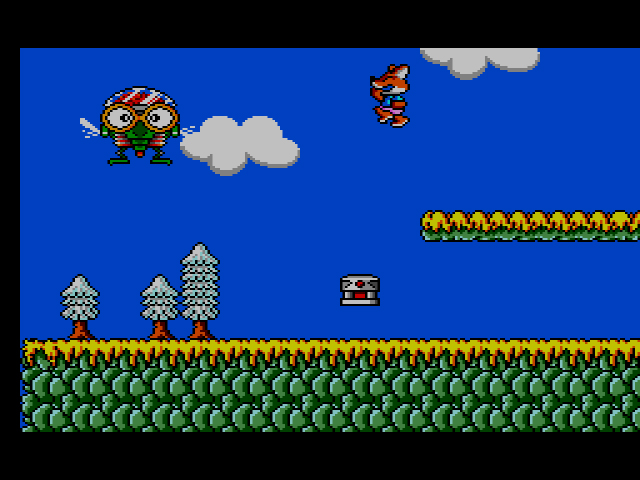
According to the Psycho Fox manual, the bonus round is based on a lottery in Japan called “Amida.” “‘Amida’ is a way of conducting a lottery to get prizes,’ the manual states. You’re presented with five pathways, four of which lead to a bonus of sorts, while one leads to a black hole/no bonus. The amount of money bags you have dictates how many paths you’re allowed to take. Each money bag you place before the pathways causes a Psycho Fox to appear on the path. Psycho Fox walks these paths automatically, turning left or right any time he comes to a juncture before moving forward. The layouts are different every time, so there’s no memorization, just pure gambling. The items you win are the same kind found in the eggs – Straw Effigy, Magic Medicine, and Psycho Stick respectively. One path, however, contains a pagoda that rewards you with extra lives via a slot machine. Japan sure loves their gambling.
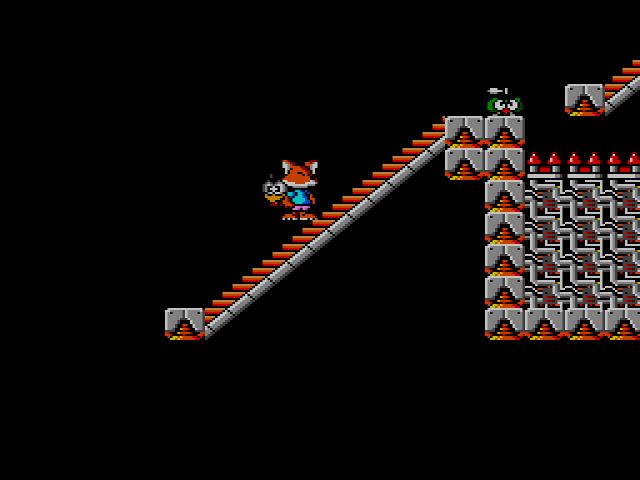
Psycho Fox was not born in a Japanese creative bubble. Any idea that seems unique to the latter started in Kid Kool, a Famicom/NES game that Vic Tokai released in 1988. The inertia-based physics, the little attack buddy (in this case, a strawberry creature) who doesn’t always move where you want him too, squishing enemy heads into the ground, running and jumping with reckless abandon (but not too much): all from Kid Kool. So why should Psycho Fox get the credit for the latter’s ideas? Because Psycho Fox is playable. The physics aren’t as refined in Kid Kool, and as a result, the game boasts more cheaper deaths and frustration. If anything, the game should be viewed as a test run for Psycho Fox. Years later, Vic Tokai would revisit these same ideas in DeCap Attack for the Genesis because you just can’t keep good inertia down.
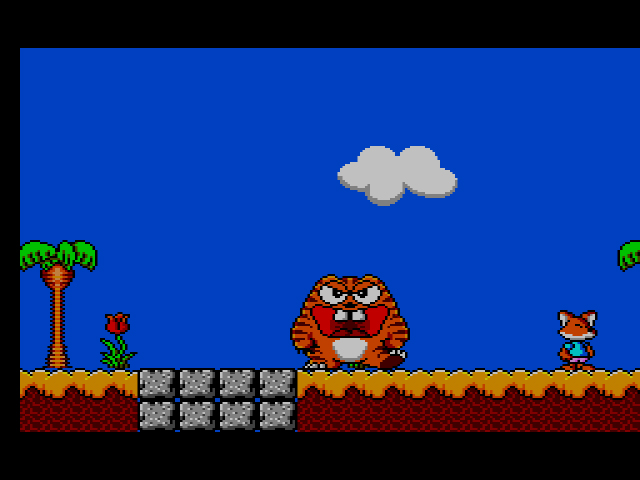
Without Vic Tokai’s wild, merciless creativity, Psycho Fox wouldn’t be the platformer that it is. And yet. I have this nagging notion that the game would be just as good without them. Take Bird Fly, for example. When he’s absent, you miss his cute presence. But when he’s with you, you wish he wasn’t so clingy, that you could punch without him feeling like he needed to be your main weapon. You already have an attack. Should he even be in the game when he alternates between helpful and unnecessary? And switching between animal friends is cool, but why does it require an item? Particularly when you’ll play as the Fox most of the time. The physics make for an interesting ride, but do they enhance the game at all or were they just added to tie in with Vic Tokai’s other platformer, Kid Kool? Psycho Fox invites introspection because, frankly, few platformers try this hard. The game longs for your affection, and while you’re not always swayed by its displays, you admire its boldness.
B
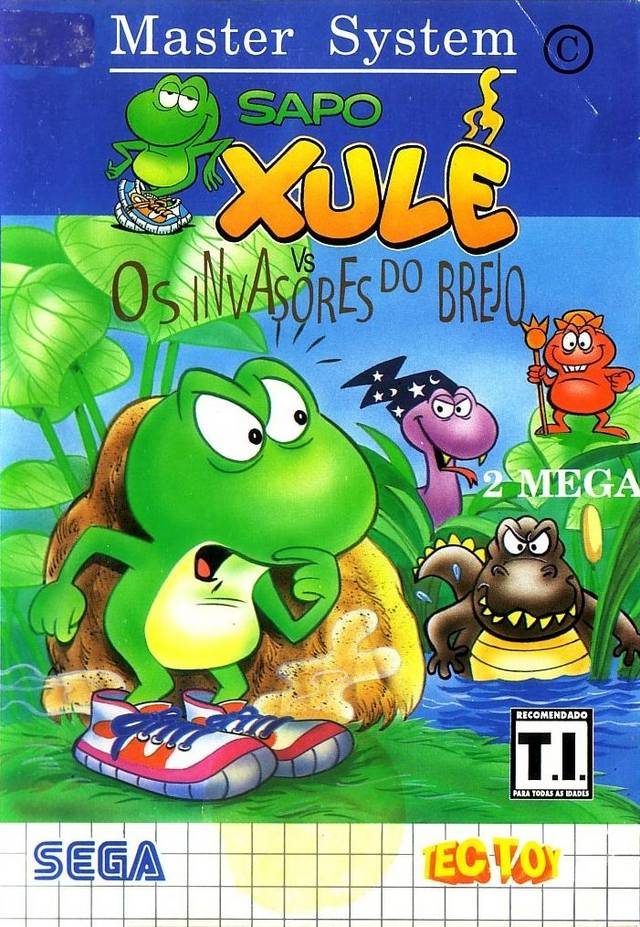
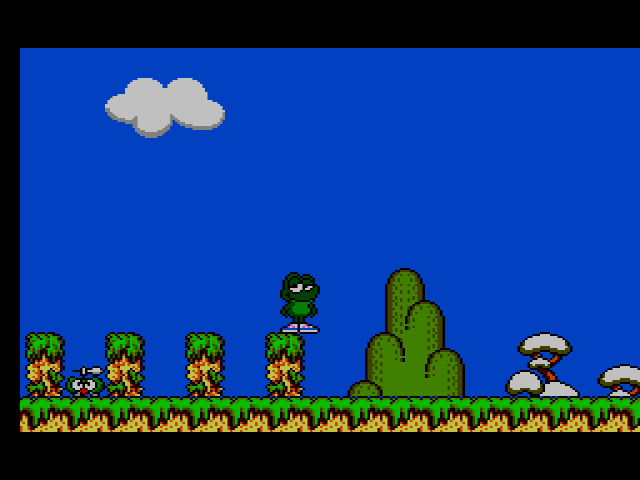
PLAYERS: 1
PUBLISHER: Tectoy
DEVELOPER: Vic Tokai (“port” by Tectoy)
GENRE: Platformer
RELEASE DATE: 1995 (BR)
And what would a Master System platformer be without a Sapo sprite swap. The funky cartoon frog from Brazil replaces Psycho Fox, while his Hippo, Monkey, and Tiger transformations are replaced by Pig, Rat, and Turtle respectively. The items, Psycho Sticks, Effigies, and Magic Medicine are now Potions, Socks and Flies. Everything else, from the enemies to the level design to the jump-like-you’ve-got-a-pair physics, are exactly the same.


14 replies on “Psycho Fox (Master System, 1989)”
Nice write up! Very through. And it’s nice to see a game that deserves it, for once. A nice spike in the Master System crud plateau.
Thanks! I was happy to play something that didn’t overwhelm me with its badness.
This was one of the games I remember seeing a preview of in Sega Challenge newsletter and was looking forward to. But by the time it came out, I had sold my SMS and gotten a Genesis already. The first of many SMS games I missed I suppose. Always wanted to play this. I suppose this is a good enough recommendation to boot it up on an emulator sometime. I had only recently found out about its relation to Kid Kool and Decap Attack (Magical Hat something or other in Japan). Decap attack is something of an interesting game in its own right receiving the SMB2 treatment when it came here. Too bad you didn’t get hard release dates on these titles and are doing the remainder of the SMS releases alphabetically. I really can’t wait to get to Wonderboy 3 at the end of the alphabet.
Wonderboy III will be the crown jewel at the end of the line. Or, at least, that’s what everybody says.
you’re going alphabetically now?
If yes I’m assuming psycho fox is not a part of that. Would that be correct?
I’m only going alphabetically when there’s no concrete Month/Date/Year release. US and European released games, for whatever reason, only provide the year of release.
Looking forward to reading about Wonder Boy 3, heck maybe it will be that good that I will find a copy and fire up my SMS.
Until then, my crown jewel for the end of the system’s life is Golden Axe Warrior.
I’m quite agog for your review of Gain Ground. I have both the Master System and Genesis version of the game. Personally I think the Master System version is much better. I await your opinion of the two with much anticipation. (Get a buddy to beat GG with, one that loves memorizing patterns and replaying a game too many times to win)
I enjoyed the Genesis version, but you’ve piqued my interest for the Master System version. And good call on the co-op.
I’m reminded of the awesomeness of Little Samson and the horrors of 8 Eye’s.
So in Brazil the turtle has the long jump?
I guess so? I’ll be honest, I didn’t try out the other characters, just Sapo
Glad you mentioned Decap Attack, because it’s a favorite of mine from childhood, and I found out a few years ago was sort of a spiritual successor, of sorts, to Psycho Fox. This is another SMS game that, depending on who you talk to, is either a really great game, or just sort of okay. I think for SMS owners aching for a better platforming experience than what the Alex Kidd games offered, this was a breath of fresh air, but I get that some folks don’t like (or just plain can’t handle) the inertia thing.
Sorry to hear you weren’t hyperbolic about this game – I hoped you’d enjoy it more.
Psycho Fox is one of my top three SMS games, and still one of my favourite platformers regardless of system. I love the multiple paths, the wild animations for death and when you run out into oblivion, the way you can repeatedly slam Bird Fly at high speed into nearby platforms (for comic effect and to defend against enemies that are advancing down stairs toward you), the inventive (and yes, easy) bosses, the slightly creepy warp zones, the graphics and music. I could go on. I agree that the heavy physics might be an unnecessary innovation, but I think they make it satisfying to master, at which point they also become second nature.
By the way – the effigy sucks enemies in from off-screen, so it’s handy when you need to make a leap of faith.